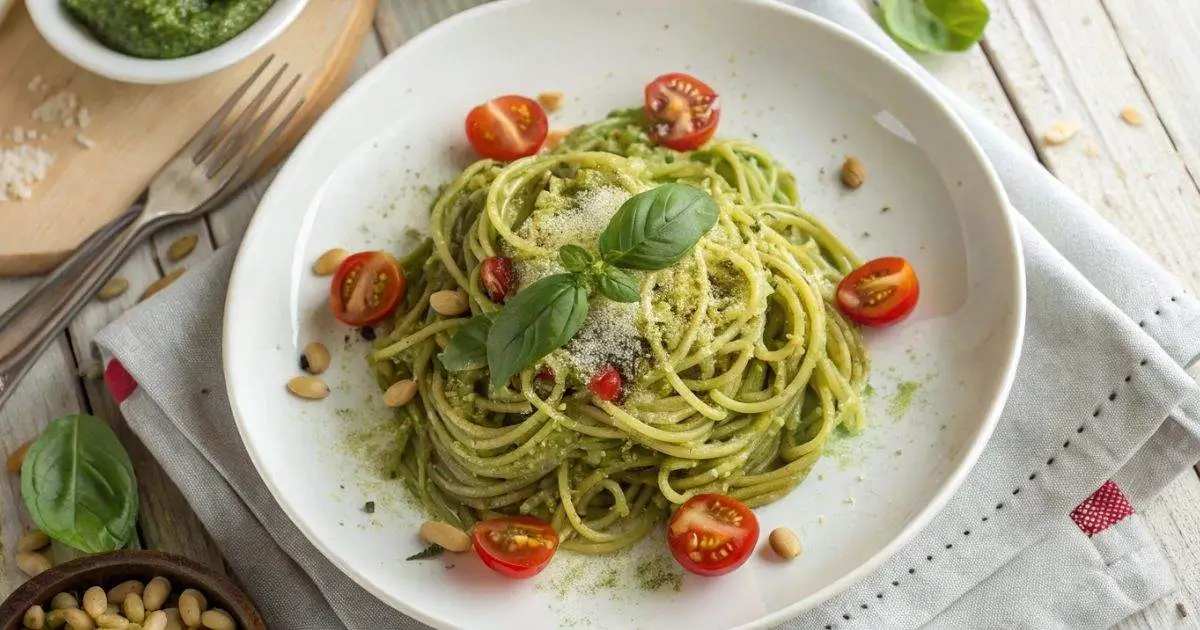I wanted to impress my friends with a perfect pasta al pesto. I had everything ready—fresh basil, pine nuts, garlic, Parmesan—except a food processor. “I’ll just use the blender,” I said. What followed was a kitchen disaster: green splatters everywhere, pine nuts flying like bullets, and a blender screaming for mercy. But when we finally ate, my friends said, “This is the best pesto we’ve ever had!” Turns out, chaos can taste amazing.
Pasta al pesto is a timeless Italian dish that brings together the rich flavors of fresh basil, garlic, pine nuts, Parmesan, and extra virgin olive oil. It’s a simple yet flavorful recipe that’s quick to prepare, making it an ideal meal for busy weekdays or a weekend gathering. The dish is deeply satisfying, with the pesto sauce perfectly coating the pasta, creating a harmonious blend of aromatic and savory notes.
Whether you’re a seasoned home cook or a beginner, making pasta al pesto is a fun and rewarding experience. By using fresh ingredients and a few essential kitchen tools, you can create a dish that rivals those served in the best Italian restaurants. Let’s dive into the key benefits of this easy and delicious recipe.
Table of Contents
Table of Contents
Key Benefits For Pesto Pasta
- Fresh Ingredients: The pesto sauce is made using fresh basil, garlic, and high-quality extra virgin olive oil, all of which provide essential nutrients. Basil is rich in antioxidants, vitamins, and minerals, while garlic is known for its immune-boosting properties.
- Quick and Easy: Unlike many pasta dishes that require long cooking times or complicated preparations, pasta al pesto is incredibly fast to make. In just about 20 minutes, you can enjoy a full, flavorful meal.
- Customizable: You can easily adapt the dish to your tastes or dietary needs. For instance, if you’re dairy-free, you can skip the Parmesan cheese or use a plant-based alternative.
- Versatile: Pasta al pesto works well with a variety of pasta shapes, whether you prefer linguine, penne, or spaghetti. You can even mix in roasted vegetables, grilled chicken, or tofu to add extra protein and flavor.
- Naturally Gluten-Free: If you use gluten-free pasta, this dish is naturally gluten-free, making it accessible to people with dietary restrictions.
- Vegetarian and Nutritious: Packed with healthy fats from olive oil and nuts, along with the vitamins and minerals from fresh basil and garlic, this dish is a great option for vegetarians and those looking to maintain a balanced diet.
Simple ingredients
To make a classic pasta al pesto, you’ll need the following ingredients:
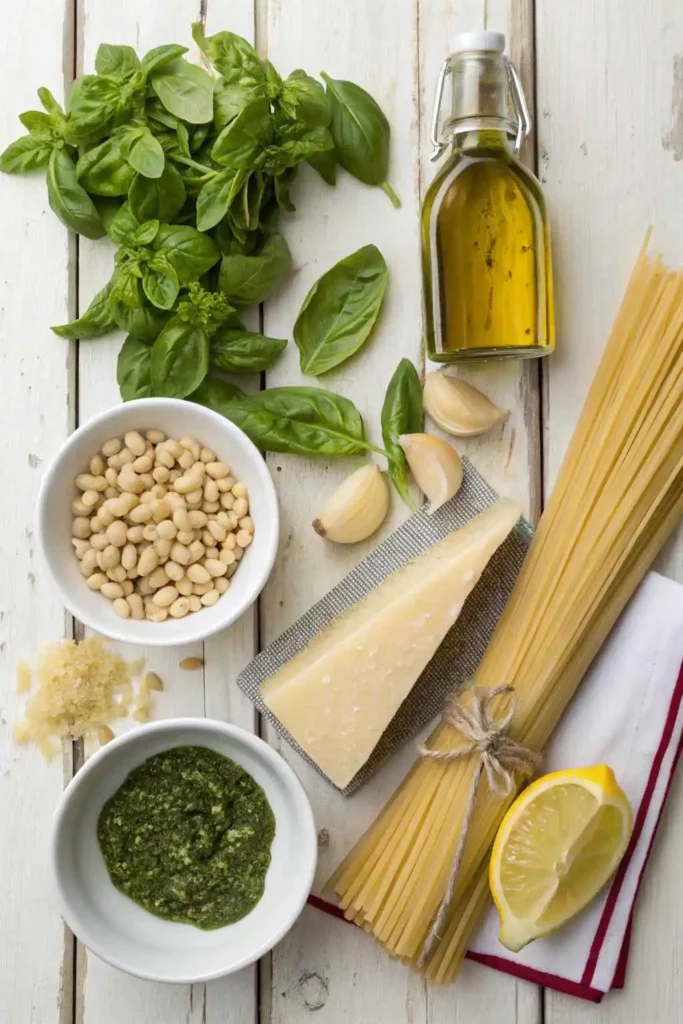
For the pesto sauce:
- 2 cups fresh basil leaves (packed)
- 2 cloves garlic, peeled
- 1/4 cup of pine nuts (or substitute with walnuts if preferred)
- 1/2 cup freshly grated Parmesan cheese (or nutritional yeast for a vegan version)
- 1/2 cup extra virgin olive oil
- 1/4 teaspoon sea salt (adjust to taste)
- 1/4 teaspoon black pepper (freshly ground)
- 1 tablespoon of lemon juice (optional, but adds a nice touch of freshness)
For the pasta:
- 1 pound (450g) pasta of choice (linguine, spaghetti, or penne work well)
- Salt, for boiling the pasta water
Optional:
- 1/2 cup cherry tomatoes, halved (for a fresh touch)
- Grilled chicken, tofu, or roasted vegetables (for added protein or variation)
Why These Ingredients Work:
The combination of fresh basil, pine nuts, garlic, Parmesan, and olive oil creates a balanced sauce that’s both creamy and flavorful. The pasta acts as the perfect canvas, allowing the pesto to shine. Optional add-ins like cherry tomatoes or grilled chicken can elevate the dish, making it more substantial and visually appealing.
Pine nuts are a nutrient-dense ingredient, contributing healthy fats, protein, and essential vitamins to your pesto. For a comprehensive breakdown of their nutritional content, refer to the Pine Nuts Nutrition Facts – USDA.
With these ingredients on hand, you’re ready to create a delicious Pasta al Pesto that’s sure to impress. In the next section,
Make this recipe
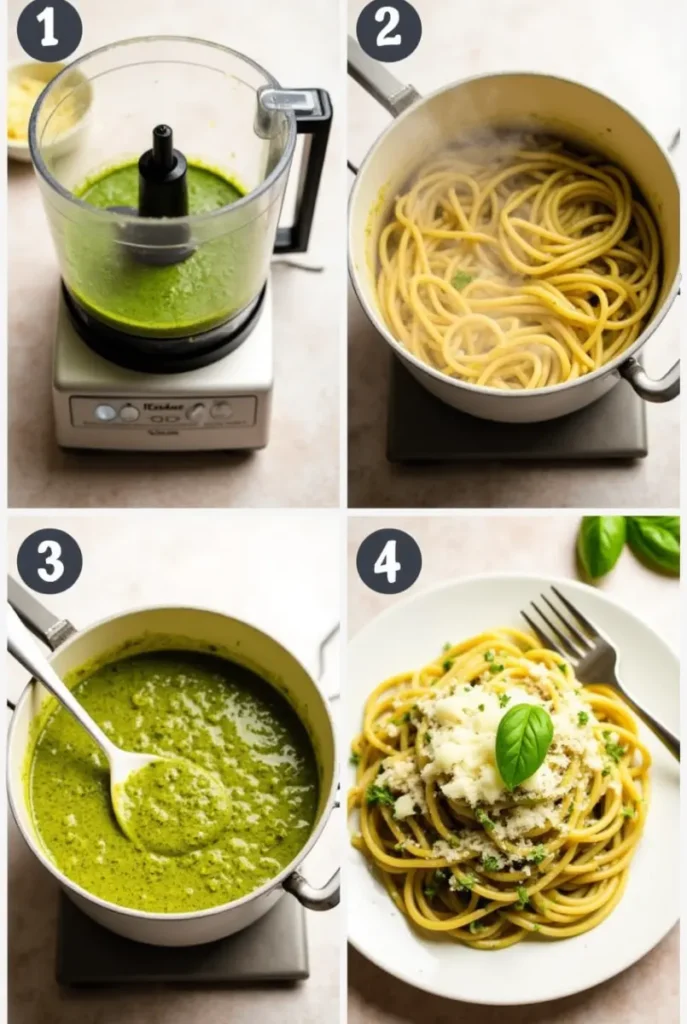
Step 1: Prepare the pesto sauce
- Toast the nuts (optional): If you want a deeper flavor in your pesto, lightly toast the pine nuts or walnuts in a dry skillet over medium heat for 2-3 minutes. Be careful not to burn them. After toasting, let them cool before using.
- Blend the ingredients: In a food processor or blender, combine the fresh basil leaves, garlic, pine nuts, and Parmesan cheese (or nutritional yeast for vegan pesto). Give it a few pulses to break up the ingredients.
- Add the olive oil: With the food processor running, slowly pour in the extra virgin olive oil. Continue processing until the mixture forms a smooth, creamy paste. Scrape down the sides as needed.
- Season the pesto: Taste the pesto and adjust the seasoning with salt, pepper, and lemon juice. The lemon juice adds brightness and balances the richness of the olive oil.
Step 2: Cook the pasta
- Fill a large pot with water, add salt, and bring it to a boil over high heat. Add your pasta and cook according to the package instructions for “al dente” pasta (usually 8-10 minutes depending on the type). Be sure to save around 1 cup of pasta water before draining.
- Drain the pasta, but don’t rinse it—keeping a bit of the starch helps the pesto adhere to the pasta.
Step 3: Combine pasta and pesto
- Transfer the freshly cooked pasta to a large serving bowl or pot. Add 2-3 tablespoons of pesto (or more, depending on how saucy you like your pasta).
- Toss the pasta with the pesto, adding a bit of the reserved pasta water to help the sauce coat the noodles. Toss the pasta thoroughly until the pesto is evenly distributed.
Step 4: Serve and garnish
- For a burst of freshness, you can add halved cherry tomatoes or roasted vegetables. Grilled chicken or tofu is also a great addition for added protein.
- Serve the pasta hot with extra grated Parmesan on top, if desired.
Pro Tip: If you’re making the pesto ahead of time, store it in an airtight container in the fridge for up to 5 days or freeze it for up to 3 months. To prevent discoloration, drizzle a thin layer of olive oil on top of the pesto before sealing the container.
Pro Tips and Variations For Pasta Recipe
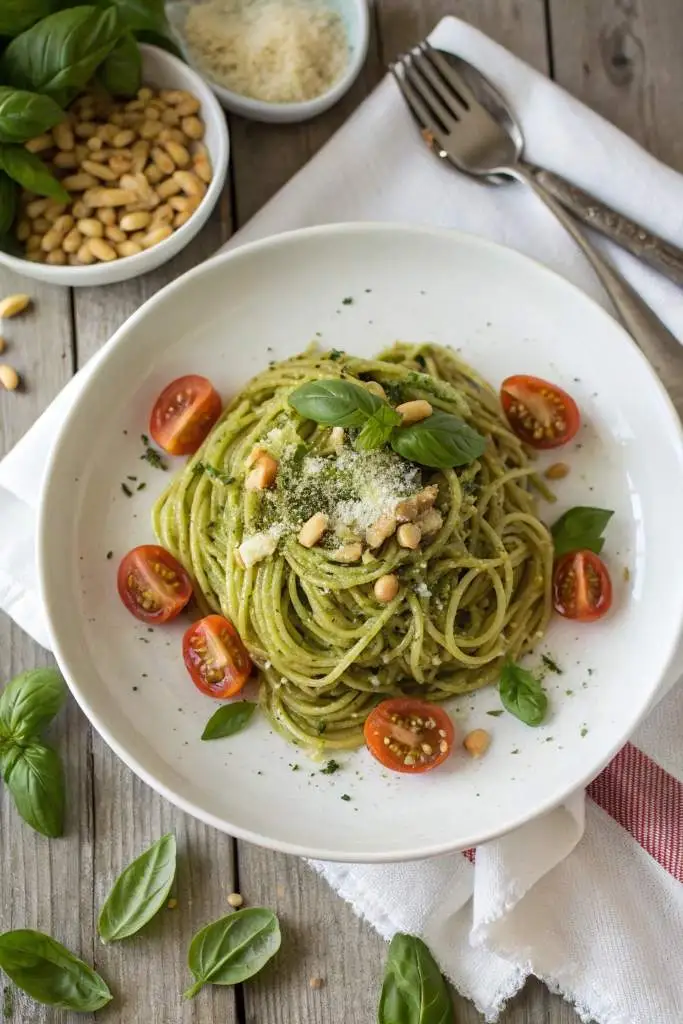
- Adjust the texture: If the pesto is too thick, you can thin it out by adding a bit more olive oil or a splash of the reserved pasta water. This will help the pesto coat the pasta more evenly.
- Make it spicy: For a bit of heat, add a pinch of red pepper flakes to the pesto mixture.
- Use different nuts: While pine nuts are traditional, you can experiment with walnuts, almonds, or cashews for a unique flavor. Each nut will give the pesto a slightly different texture and taste.
- Try different cheeses: If you’re looking for a dairy-free version, skip the Parmesan and use a vegan cheese or nutritional yeast for a cheesy flavor.
- Make it ahead: Pesto can be made ahead and stored in an airtight container in the fridge for up to 3 days. To prevent browning, drizzle a little extra olive oil on top before sealing.
- Add protein: For a heartier dish, consider adding grilled chicken, shrimp, or roasted vegetables. Tofu also makes a great plant-based protein addition.
Serving Suggestions For Pasta al Pesto Recipe
Pesto pasta is a versatile dish that pairs well with a variety of sides and accompaniments. Here are some options to complement your meal:
- A side salad: A simple green salad with mixed greens, arugula, or spinach, tossed with a light vinaigrette, complements the richness of pesto perfectly.
- Bread: Serve the pasta with crusty bread or garlic bread for a deliciously satisfying meal.
- Roasted vegetables: Roasted zucchini, eggplant, or bell peppers make excellent additions to pasta al pesto, bringing in a slight sweetness and extra texture.
Protein Additions
- Grilled Chicken: Slice grilled chicken breast and serve it on top of the pasta.
- Shrimp: Sauté shrimp with garlic and olive oil, then mix it into the dish.
- Grilled Salmon: Serve a fillet of grilled salmon alongside the pasta for a luxurious touch.
Antipasto Platter
- Cured Meats: Prosciutto, salami, or coppa.
- Cheeses: Mozzarella, provolone, or aged Parmesan.
- Olives and Pickles: A mix of marinated olives, artichoke hearts, and pickled vegetables.
- Breadsticks or Crackers: For a crunchy element.
Dessert
- Tiramisu: A creamy, coffee-flavored dessert that’s always a crowd-pleaser.
- Panna Cotta: A silky, vanilla-flavored custard topped with fresh berries.
- Gelato: Serve a scoop of your favorite gelato flavor for a refreshing finish.
__________________________________________________________________
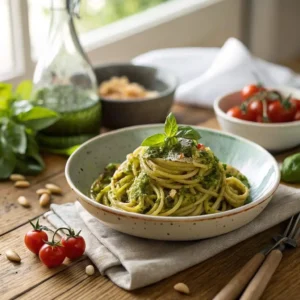
Pesto Pasta
Ingredients
- 2 cups fresh basil leaves packed
- 2 cloves garlic
- ¼ cup pine nuts or walnuts
- ½ cup grated Parmesan or nutritional yeast for vegan
- ½ cup extra virgin olive oil
- Salt and pepper to taste
- 1 tablespoon lemon juice optional
- 1 pound pasta linguine, spaghetti, or penne
Instructions
- Prepare Pesto: In a food processor, blend basil, garlic, pine nuts, and Parmesan. Slowly add olive oil until smooth. Season with salt, pepper, and lemon juice.
- Cook Pasta: Boil pasta in salted water until al dente. Reserve 1 cup of pasta water before draining.
- Combine: Toss pasta with pesto, adding reserved pasta water as needed to coat evenly.
- Serve: Garnish with extra Parmesan, pine nuts, and fresh basil.
Pro Tips
- Toast pine nuts for a deeper flavor.
- Add grilled chicken, shrimp, or roasted veggies for extra protein.
- Store pesto in the fridge for up to 5 days or freeze for 3 months.
Notes
- Calories: 450 kcal
- Fat: 25g (Saturated Fat: 5g)
- Protein: 12g
- Carbohydrates: 45g (Fiber: 3g, Sugar: 2g)
- Sodium: 300mg
Conclusion
Pasta al pesto is a simple, flavorful dish that brings together the best of Italian cuisine in just a few steps. Whether you’re making it for a quick weeknight dinner or serving it at a gathering, this recipe is sure to impress with its fresh, vibrant flavors and versatility. By making your own pesto, you control the quality and taste, ensuring each bite is filled with the natural goodness of basil and high-quality ingredients.
So grab your pasta of choice and dive into the world of pesto—it’s a dish you’ll want to make over and over again!
FAQs About This Pesto Pasta recipe
Comment utiliser le pesto sur les pâtes ?
To use pesto on pasta, simply toss the freshly cooked pasta with a few tablespoons of pesto sauce. You can add a bit of reserved pasta water to help the sauce coat the noodles more evenly. The pesto should perfectly adhere to the warm pasta, offering a flavorful coating.
Est-ce que la sauce pesto se fait chauffer ?
No, pesto is traditionally served at room temperature or cold. Heating the sauce can alter its fresh and vibrant flavor, especially if it contains basil. Simply mix it with warm pasta for the best result.
Quel est le goût du pesto ?
Pesto has a rich, herbaceous flavor with a slightly nutty and garlicky taste. The combination of basil, olive oil, and pine nuts (or other nuts) creates a fragrant and savory sauce that complements pasta wonderfully.
Quelle plante compose le pesto ?
The primary ingredient in traditional pesto is basil. Fresh basil leaves are blended with garlic, pine nuts, Parmesan cheese, and olive oil to create a vibrant, flavorful sauce.
Comment bien utiliser le pesto ?
Pesto can be incorporated in many different ways. Besides tossing it with pasta, you can spread it on sandwiches, use it as a dip for bread, drizzle it over roasted vegetables, or add it to soups for a burst of flavor.

